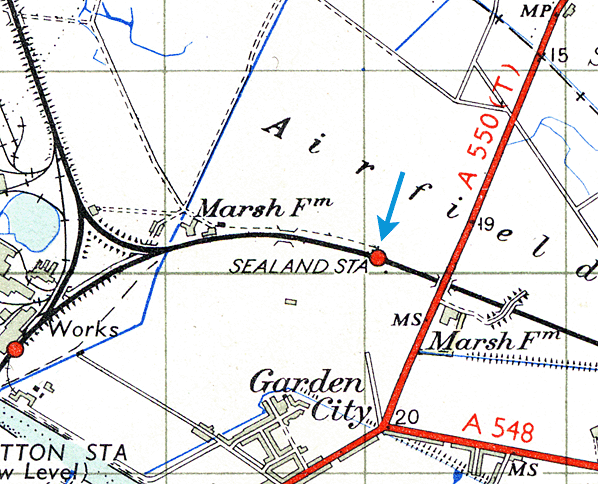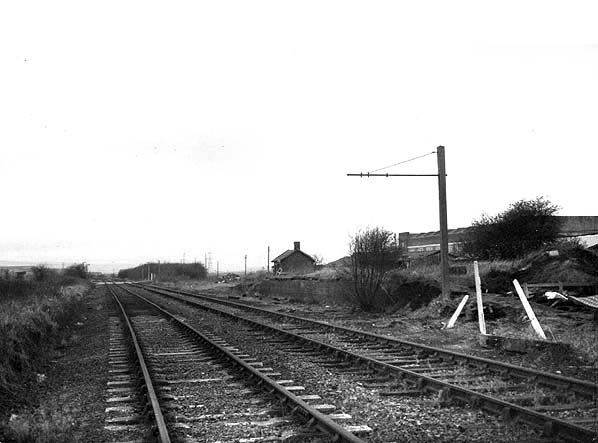| Notes: Sealand station was located on the Great Central Railway’s (GCR) Chester Northgate to Hawarden Bridge line which opened on 31st March 1890. The line was part of a through route to Wrexham Central and, from 16th March 1896, there was also a line from Hawarden Bridge to Bidston on the Wirral; this was directly accessible from Sealand as |
 |
there was an east-to-north connecting line a short distance west of the station. By 1905 the entire system between Chester and Wrexham and between Hawarden Bridge and Bidston was in GCR ownership.
Welsh Road goods siding may have opened with the line and it was certainly open by 1899 and comprised two sidings with a cattle pen on the up side of the line. During the Great War (1914 – 1918) a military camp was set up on the north side of the line at Sealand close to a main road between England and Wales: the camp would much later develop into RAF Sealand. To serve the camp, Welsh Road Halt – later known as Sealand station - was opened on 17th June 1918. It was only for the use of forces personnel. In May 1919 Welsh Road Halt was opened to the public, and timetabled services began to call there.
 |
Welsh Road Halt was located west of a level crossing just under a quarter of a mile west of the Welsh Road, after which it was originally named. The Chester and Hawarden Bridge line was double-track, so the halt was provided with two platforms. It was initially of timber construction, and each platform had simple single-storey waiting facilities. The platforms were, at |
some stage, rebuilt in concrete. On the east side of the level crossing was a signal box, located north of the line. It controlled the crossing and the earlier sidings east of the station. Being alongside a military establishment many maps had ‘security treatment’ and therefore did not show in detail the area around the station.
At the time of opening to public services Welsh Road Halt was served by Chester Northgate - Wrexham Central and Chester Northgate – Seacombe trains; Seacombe was on the west bank of the River Mersey, with ferries to Liverpool, on the opposite bank. Through tickets were available for passengers using Welsh Road Halt.
| On 1st January 1923 Welsh Road Halt became part of the London & North Eastern Railway (LNER). On 14th of September 1931 it was renamed Sealand. Services continued to run to Wrexham Central, to Seacombe and to Chester Northgate. During the Second World War RAF Sealand was expanded into a very large complex with additional hangars and |
 |
barrack accommodation. The station would have been very busy at this time handling large numbers of forces personnel both on scheduled services and on special trains.
 |
On 1st January 1948 Sealand became part of the nationalised British Railways’ Eastern Region, though some months later the ex-LNER lines in the Wirral and NE Wales were transferred to the London Midland Region. In 1957 Sealand had seventeen trains to Chester Northgate, eight to Shotton High Level, two to Buckley Junction and six to Wrexham Central on |
weekdays. Extra services ran on Saturdays and even on Sundays, when Sealand had eight trains to Chester Northgate, six to Shotton High Level and two to Wrexham Central. At this time passengers for Seacombe were encouraged to change at Shotton High Level.
By 1960 though no trains called at Sealand. In the same year DMUs were introduced onto the line.
| The Reshaping of Britain’s Railways (Beeching) report of 1963 recommended the withdrawal of all services from Sealand. However a year later the station still had fourteen weekday services to Wrexham Central, twelve to Shotton High Level, six to New Brighton - trains were diverted there when Seacombe closed at the beginning of 1960 - and |
 |
thirty-two to Chester Northgate. This was a more intense service than had operated in the 1950s.
Goods facilities were withdrawn on 5th April 1965 although a private siding remain in use. Despite local protest the services between Chester Northgate and New Brighton, and between Chester Northgate and Wrexham, were withdrawn on 9th September 1968, and Sealand Station closed completely. It appears to have been demolished shortly after closure. The private siding remained in use and although the passenger station had been demolished. The goods dock to the east of the crossing were extant in 1985 although the sidings had been lifted.
 |
The line continued in use for goods traffic between Hawarden Bridge Junction and Mickle Trafford until 20th April 1984. On 31st August 1986 the line reopened, again only for goods services. It was reopened as single-track, and at Blacon only the former Chester direction line was retained. The reopening was short-lived, and the line closed again in |
June 1992. The track was mothballed for a while, but it was lifted before the end of the decade. In 2000 a footpath and cycleway was opened along the course of the line. A station concrete lamp column still survives at Sealand.
Tickets from Michael Stewart, route map drawn by Alan Young, timetable from Chris Totty
To see other stations on the Chester Northgate to Wrexham Central Line click
Chester Northgate, Chester Liverpool Road,
Blacon, Saughall, Chester Junction Golf Club Platform, Chester Golf Club Halt, Hope High Level, Rhosddu, Wrexham Exchange, Wrexham Central
See also stations between Chester Junction and Bidston
Birkenhead Junction Golf Club Platform, Sealand Rifle Range Halt, Burton Point, Storeton
See also
Liscard & Poulton & Seacombe
See also related items
Hawarden Loop
Hawarden Bridge
Railways at Bidston |

old3.jpg)



old2.jpg)


old5.jpg)


 Home Page
Home Page 







old_thumb4.jpg)
thumb1.jpg)

thumb4.jpg)
thumb5.jpg)
thumb6.jpg)
